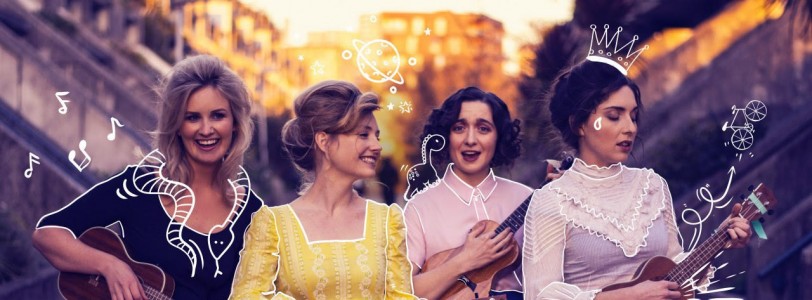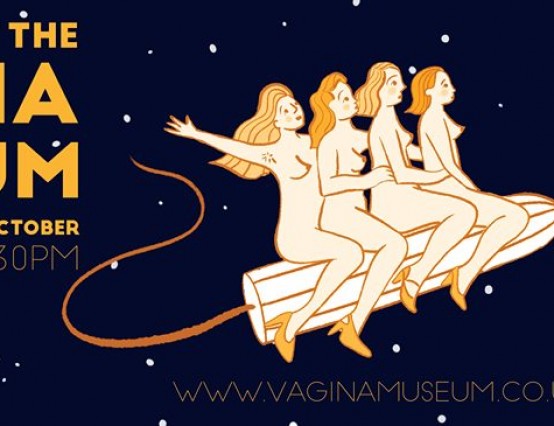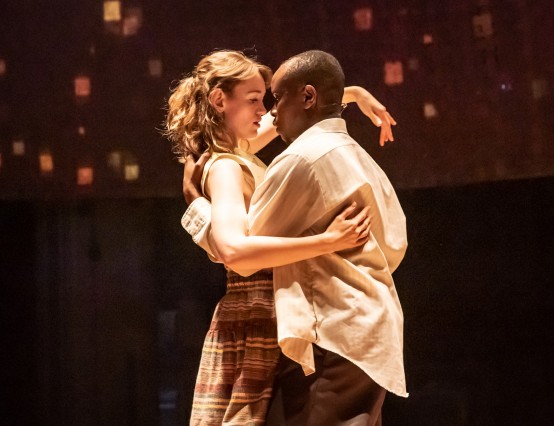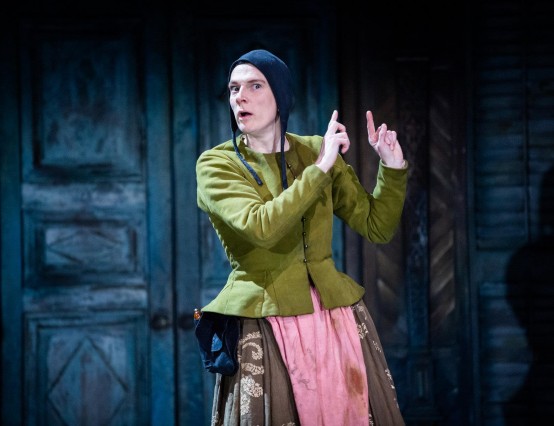I have had the absolute pleasure of working with these wonderful ladies at RADA Festival back in the summer of 2018 on their last show, and from the minute we received their script in an email, I knew their show would be my favourite one of the season. I can confidently say I was 100% right. Here’s a chance to get to know them and to gain an insight into their work.
Can you introduce yourselves to the readers?
Aurora: Hello! We’re Polly Clamorous, I’m Aurora Richardson.
Stefanie: My name is Stefanie Bruckner.
Jamie: I’m Jamie Bell.
Isabelle: And I’m Isabelle Woolley.
Can you tell us more about the group and what you do?
Jamie: We call ourselves a comedy cabaret quartet; sometimes we call ourselves a band, but we still haven’t really figured out whether or not we like that term. We’re essentially just a collective of women who love making music and women who love making music about women. We came together when Aurora (Rory) was doing her dissertation ‘Ovary Dose’ at RADA in 2017. Rory just said, ‘I need some women to join me in what I want to do’, and she was so open and welcoming, and there was no vetting process, she just said to us, ‘if you like what I do, then come and join me’. So we did, and here we are!
I’m going to ask, because everyone is going to want to know…can you explain the group name?
Aurora: So ‘clamorous’ has a few meanings. On one hand it has to do with protest and demand, which seems to form the basis of everything we write. On the other, it relates to making a loud and confused noise, which also sounds about right!
Isabelle: There’s also the obvious play-on-words with ‘Polyamorous’, but we put the double ‘l’ in Polly which made it into an everyday name, sort of along the lines of Jane Doe. We get a lot of emails now, even though I say ‘Hi, I’m Isabelle from Polly Clamorous’ we get a lot of emails back that say ‘Hi Polly’. So we like to roll with it.
Stefanie: Polly has become the big female figure between the four of us.
Aurora: And if you remember, there’s Polly Pocket who lives in a clam. So now we have three layers, so there’s something for the whole family!
Jamie: Jo, the more you ask us, the more layers we are going to find!
Can you explain what your show is about?
Jamie: So our first show, Lady and the Cramp (our first comedy cabaret); was a musical exploration through personal testimony and while we enjoyed it and we found we really connected with it, we kind of thought, “we’re all, what, in our mid-20s? How interesting can our lives actually be? “So then we started looking into history, and found that there were these really enigmatic women that we were fascinated by or drawn to. We went out, researched them, brought them into rehearsals in January and we experimented with turning those stories into songs…
Aurora: ‘Musical portraits!’ *winks*
Jamie: Musical portraits. But we had to gather our sources from different places, because obviously, mainstream narratives give you one story of a woman’s life, and her actual writings give you a totally different story. So that was quite interesting for us, finding the real distance between what has been reported and what has been said about a woman’s life in contrast to the nuances and the societal sh*t behind the events in her life. So I guess that’s where HERSTORY comes from.
What have been the challenges in making HERSTORY?
Stefanie: The biggest challenge this time around has also been the biggest breakthrough - we’ve always prioritised inclusivity and wanted to make HERSTORY as accessible as possible. We were lucky enough that RADA put us in touch with Anna Trethewey - a hugely talented BSL interpreter who brings the show to life in a new and exciting way.
Jamie: I would like it said that we are hyper-aware of the fact that all of the women we have chosen to talk about are white, Western women, because we are white, western women. Because the nature of the show is embodiment, we started thinking about the women of colour who we wanted to talk about, and found that direct representation was an idea we were all really uncomfortable with. At the point the show is now, we are still in conversation with BAME actors and musicians, talking about how we can integrate stories of colour without heading into appropriation.
Isabelle: As company treasurer, a title I take on with “tremendous pride”, I’d say that funding is the black thing with feathers that keeps us up in cold sweats until 3 in the morning. This year our bid for Arts Council funding was successful - HURRAH! We’re so grateful for their support, and the fact that they see the value in what we do.
Stefanie: Another challenge has been dealing with the unspoken expectation that we’re only here to celebrate “strong” or “empowered” women. It’s worth mentioning that we’re not only celebrating women for their amazing achievements, but also acknowledging in our own way the very real struggles of women that, in essence, haven’t changed. HERSTORY talks about women who fought body dysmorphia and the Roman Empire, who ran brothels on the docks, were serial killers and seductresses. We’re trying to look at a broader spectrum of womanhood.
Isabelle: Three-dimensional human beings in fifty-five minutes.
Jamie: History is an important way for human beings to understand themselves, and if women don’t show up there, or only show up as witches, hysterical sycophants, seductresses, mothers and cleaners, how do you change the shape of the future?
Aurora: What I’ve found throughout the process of making the show is how women’s liberation often feels like a disjointed conga line, we’re always going two steps forward and then one step back. We want to experiment with the question - how far have we come? Can we still connect with the stories of women who’ve come before? Can we ask these questions? But we also try to use comedy as a way to relieve the very 2019-specific tensions and uncertainties that tend to smother these dialogues.
Stefanie: I think it’s important for us to open up people’s minds about how women are perceived, portrayed and even mythologised. That there’s more than one way to look at them, that there’s a human being behind the myth and to just give more thought and more ground to them.
You write all your own songs. What’s your process? Do you have certain roles in the songwriting process or is it totally collaborative?
Isabelle: It’s probably a mixture. Sometimes someone will come in with a whole song already formed, then we all clamber on board and help edit it. Or sometimes we can be like ‘I’ve only got one line!’, so we’ll all sit down and build the song together.
Jamie: Or we’ll come in and be like ‘Issy! For this piano part, I want it to sound a bit like Chopin!’
Isabelle: And I’m like: *weeps*
Jamie: You’re like ‘let me manage your expectations…’
Aurora: We also use an array of instruments to decorate the women, so each character kind of has their own musical style. From blues and jazz, to circus tunes, to naughty sea-shanties.
Stefanie: Mary Anning even has a punk song!
Isabelle: Because she’s very punk.
Do you take inspiration from anyone or anything in particular?
Jamie: So Rory, Stef and Issy are really good at taking things they’ve seen outside, bringing them in and saying ‘this moved me’, and we kind of deconstruct why and how. So I think there are definitely performers or performances we look up to, but I would say we are more inspired by different sounds. Being curious about sound I think is something that we all share.
Isabelle: Yeah, experimenting with tone, resonance, pitch and rhythm helps us to create atmospheric work.
Aurora: Also, at the moment there’s been a noticeable surge of female-centric shows that are making it on to West End and other mainstream theatres. It’s really inspiring, but also encouraging as theatre makers to see shows like Emilia, SIX Musical and Sylvia with strong female narratives and characters, gaining so much traction and momentum on the big stage. There’s a real buzz that's being generated and I think we would all agree - it’s about time!
Jamie: I would say we’re like the weird cousin of those shows, with a bit of a sick sense of humour. To get what we do you have to have a good sense of irony.
You’ve done Brighton Fringe, you’re doing RADA Festival, and you’ll be returning to Edinburgh Fringe in August. What is it you enjoy about fringe shows?
Aurora: The audiences! Afterwards they come up and talk to you, and you find there’s a real performer/audience barrier breakdown thing going on - that’s the best bit. Edinburgh Fringe last year was definitely a highlight. Having a pint and a good ol’ chat with people from all over the world.
Stefanie: It’s a wonderful place to meet other artists who work in tech, production, management as well as other performers who are so eager to share their work. It takes a lot to put on a show up there and it takes a community to support a festival of this scale, and more importantly to encourage each other to go beyond Fringe and continue to dare, experiment and keep the work going!
Jamie: One thing about Fringe that I think is important for young people to know - I think you do have to protect yourselves when you do Fringe. It’s expensive, more expensive than you think, and depending on who you work with it can be quite extortionate. So I would say the Fringe is a great place to bring experimental work and get great audiences, but on the other hand, be prepared that it’s a business.
Isabelle: And do a budget. Before you do the show.
*all nod*
Stefanie: I would love to finish this on a positive note and just say that if you have a group of people or a show you really believe in and you want to try and experiment and you want to develop something, it can be a fantastic place to explore.
Finally, if you could each give a piece of advice to young people trying to get into performance, what would it be?
Aurora: Just keep swimming! Make your own work.
Stefanie: Find your own voice. It sounds so cliché, but I think it’s really important. It can change over time, obviously. Ask yourself why you want to perform, why you want to make theatre, what is it you want to say, to put out there? I think then you’ll find the right people to work with. For me, the big one is you don’t do this on your own and you don’t have to do this on your own. There’s always the teamwork. You can be so lucky to find those people who are passionate about the same thing, who have the same values and the same sense of humour, and if you have that then just GO!
Where will we find you next?
RADA Fest in the Gielgud Theatre - 4 July, from 9pm
Streatham Space Project in Blue Plaque House’s Bedroom Sessions - 6 July, from 7:30pm
Spurgeon Secret Garden Party, part of the London National Park City Festival - 21 July, from 12pm
Camden People’s Theatre - 26 July, from 7.15pm
Assembly Ballroom Best of Cabaret - 10 & 11 August, from 11pm
TheSpace at Ed Fringe - 12 - 17 August, from 10.10 pm
Polly Clamorous are supported by funding from the Arts Council England.








0 Comments